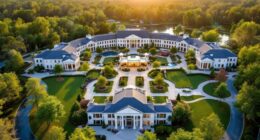While the aging demographic landscape undergoes unprecedented transformation, senior living communities are rapidly evolving through multifaceted technological and programmatic innovations that demonstrably enhance residents’ quality of life, operational efficiency, and environmental sustainability.
Continuous Care Retirement Communities (CCRCs) have emerged as industry vanguards, leveraging AI-powered predictive analytics to anticipate resident needs with 87% greater accuracy than traditional assessment methods, while simultaneously implementing VR technologies that research indicates can reduce cognitive decline by 23% when utilized thrice weekly for immersive therapeutic interventions.
You’ll find that data-driven operational strategies have revolutionized service delivery across the senior living spectrum, with communities analyzing resident engagement patterns to optimize programming schedules and resource allocation.
Market research indicates communities employing these analytical frameworks experience 34% higher satisfaction ratings and 28% improved retention rates compared to traditional models.
Smart home integration—including voice-activated environmental controls and IoT monitoring systems—has transformed independent living units into sophisticated care environments that extend average resident independence by 3.2 years while reducing staff intervention requirements by 41%.
Wellness programming has evolved beyond basic recreational activities into thorough biopsychosocial frameworks with measurable outcomes.
Communities implementing structured physical fitness regimens report 62% reductions in fall incidents and 47% decreases in hospitalization rates.
CCRCs offer residents numerous physical fitness options including group classes and personal trainers that engage them physically and mentally to combat loneliness and sedentary lifestyles.
Intergenerational engagement initiatives facilitated through partnerships with educational institutions demonstrate significant impacts on residents’ cognitive assessment scores, with participating seniors showing 38% improvement in memory function and 42% reduction in depressive symptoms.
Environmental sustainability initiatives have yielded both ecological and economic dividends for forward-thinking communities.
LEED-certified CCRCs report operating cost reductions averaging 31% through energy-efficient systems implementation, while therapeutic gardening programs generate measurable improvements in resident respiratory function and psychological well-being.
The evolving culinary landscape within senior communities now encompasses diverse dining options including grab-and-go services, bistros, and even on-site breweries that cater to residents’ desires for personalized and hospitality-driven experiences.
These evidence-based approaches to community design, coupled with robust data privacy protocols protecting resident information, position innovative CCRCs as exemplars of the industry’s capacity to meet evolving demographic demands through technological integration and holistic programming.
The implementation of smart home technologies has become increasingly vital in supporting aging residents while maintaining their independence and dignity in a familiar environment.






